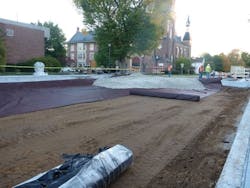Infiltration Solution
About the author: Doug Buch is president of PaveDrain LLC. Buch can be reached at [email protected].
The city of Goshen, Ind.’s concern about the undersized sewer and consistent basement backups on Jefferson Street led city officials from the engineering, storm water and maintenance departments to look into a green solution that would better infiltrate and retain rainwater to reduce sewer overflows. In the winter of 2013, they met with sales personnel from PaveDrain LLC of Milwaukee and D2 Land & Water Resources (D2LWR) of Indianapolis to discuss options.
Looking for an Answer
The system the city chose to implement accomplishes multiple tasks—paving surface, storm water infiltration, and storm water storage and management—with one unit. The arch design of the individual concrete blocks creates an internal storage chamber for storm water runoff while also providing natural strength for heavy vehicular loads. When combined with aggregate bedding stone, a natural infiltration path to remove pollutants is created that also recharges local groundwater while reducing storm water infrastructure costs.
The primary concern for Goshen city officials was maintenance, both long-term and short-term. The city had previous experience with other permeable surfaces that required frequent maintenance as well as costly replacement of small chips of aggregate between the joints.
The PaveDrain system does not require sand or small aggregate stone to be installed between the joints of the individual units due to its size, weight and interlocking feature. The system was recently part of a multiyear study, conducted by the University of Louisville Center for Infrastructure Research with financial backing from the U.S. Environmental Protection Agency and the Louisville Metropolitan Sewer District, to evaluate and establish long-term trends for maintenance. The study indicated that when the PaveDrain Vac Head is attached to a conventional combination sewer vacuum truck, the system can be brought back to more than 90% of its initial infiltration rate, even if maintenance has rarely or ever occurred. A separate, independent third-party test confirmed that the system infiltrated water around the perimeter of the block at a rate of more than 4,000 in. per hour when tested according to ASTM-C1701.
A secondary concern for the city was its ability to snow plow the permeable surface. The city had its doubts about plowing with a conventional steel blade. PaveDrain LLC personnel showed city officials photos of the system after it had been plowed using a steel blade. The blocks can be scraped, chipped and damaged, but they are too thick to be removed from the interlocking matrix. The city ultimately chose to purchase a rubber-tipped blade to keep the block surface looking new.
The final pieces of the puzzle were the soft, poor-quality soils beneath Jefferson Street. Sales personnel from D2LWR worked with geotechnical engineers from Tencate Mirafi and determined that the Mirafi RS580i was the best solution. The multi-filament geosynthetic product represents a combination of monofilaments for infiltration and flat filaments for strength while providing base stabilization, strength and separation in softer soils.
The Installation
In the spring of 2013, after reviewing various green infiltration products, the city settled on the PaveDrain system as the most viable solution in lieu of grey infrastructure. Plans and specifications were put together by the city, and in July 2013, HRP Construction of South Bend, Ind., was chosen for the job.
The project commenced in October 2013. Once the old roadway was removed and the old road base was excavated, slightly more than 30 in. of well-compacted clean angular stone was installed by the contractor on top of the RS580i. The lower 24 in. consisted of fist-sized aggregate, while the top 4 to 6 in. was ¾- to 1-in.-diameter clean angular stone. The transition from larger aggregate to smaller aggregate was compacted into place with a large vibratory steel roller. After the base preparation was finished, the installation of the prefabricated mats, totaling 17,200 sq ft of the system, took only one week to complete using the mat layout provided by PaveDrain LLC. The mats averaged 7.5 ft by 17.5 ft and weighed almost 6,800 lb. The spreader bar, attached to a Komatsu 300LC excavator, added an additional 3,000 lb.
The Results
For the city of Goshen, 2014 was the worst winter it had experienced in more than 100 years, with frost depth up to 5 ft and record snowfall. The freeze-thaw and frost heave that typically plague conventional paving solutions were not an issue. City engineer Mary Cripe reported in a letter to PaveDrain that the system performed well “under what could only be considered exceptional circumstances.”
Spring rains followed the extreme winter of 2014, but the flooding that would previously have affected the area did not occur due to utilization of the paving system. A sanctioned bicycle road race was held in the spring of 2014, and Cripe verified that no ill effects were noted by the racers who rode on the paving system.
Jefferson Street has experienced minimal settling and any initial concerns of twisting or settling blocks were eased due to the aggregate base compaction efforts of the contractor. The city of Goshen has since decided to use the PaveDrain system on additional projects. The system successfully helped to reduce sewer overflows and basement backups through storm water infiltration, and storm water storage and management.
Download: Here
